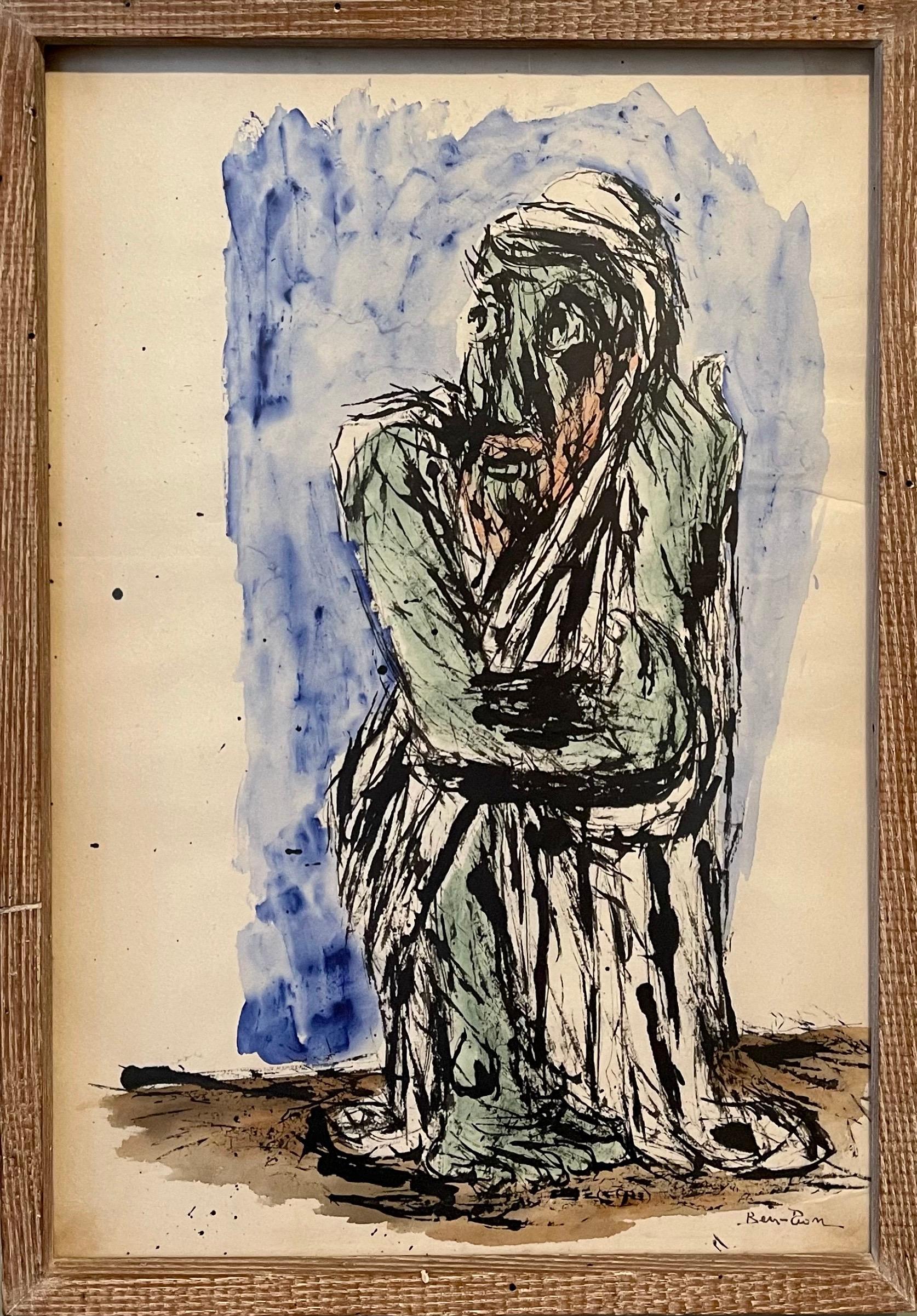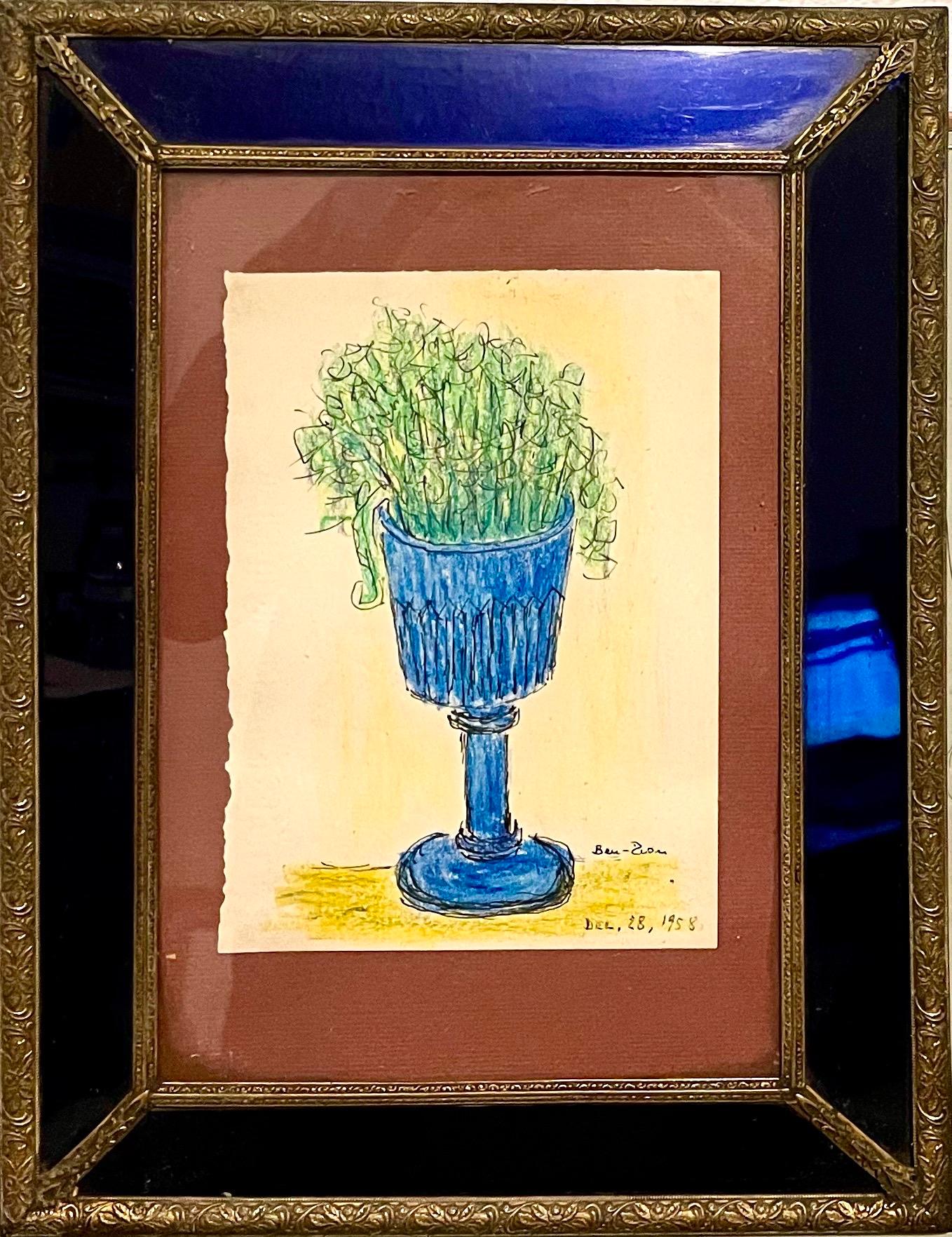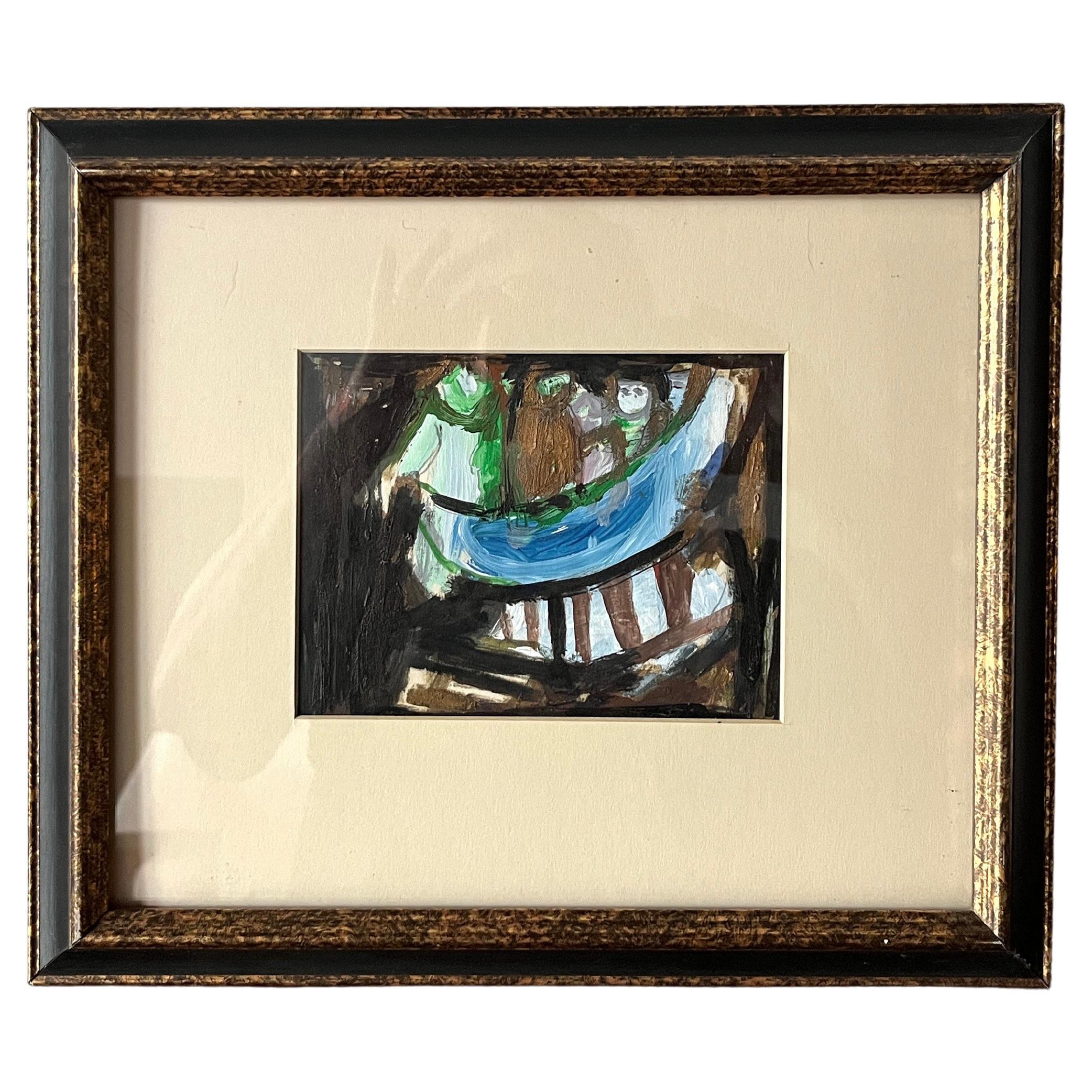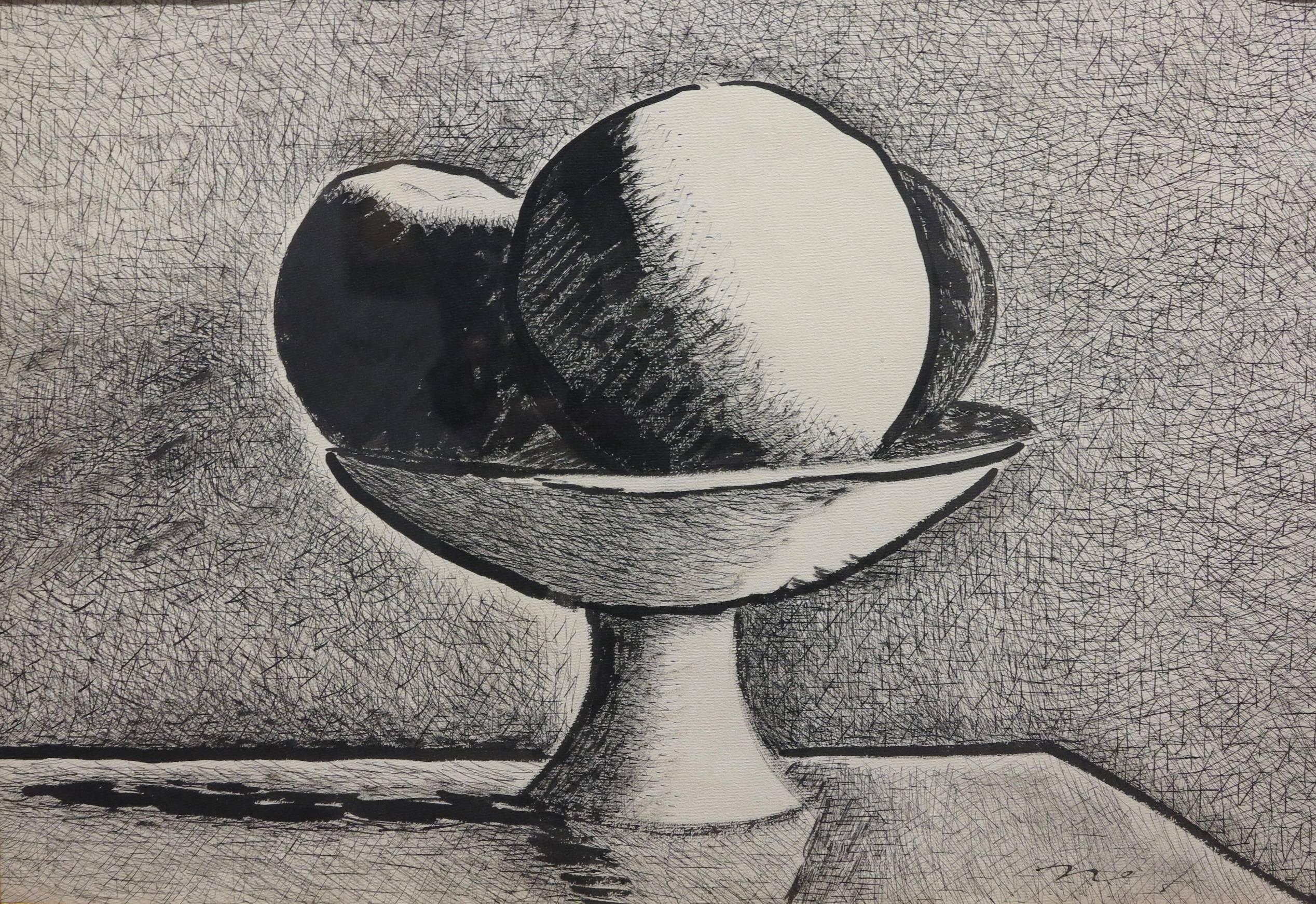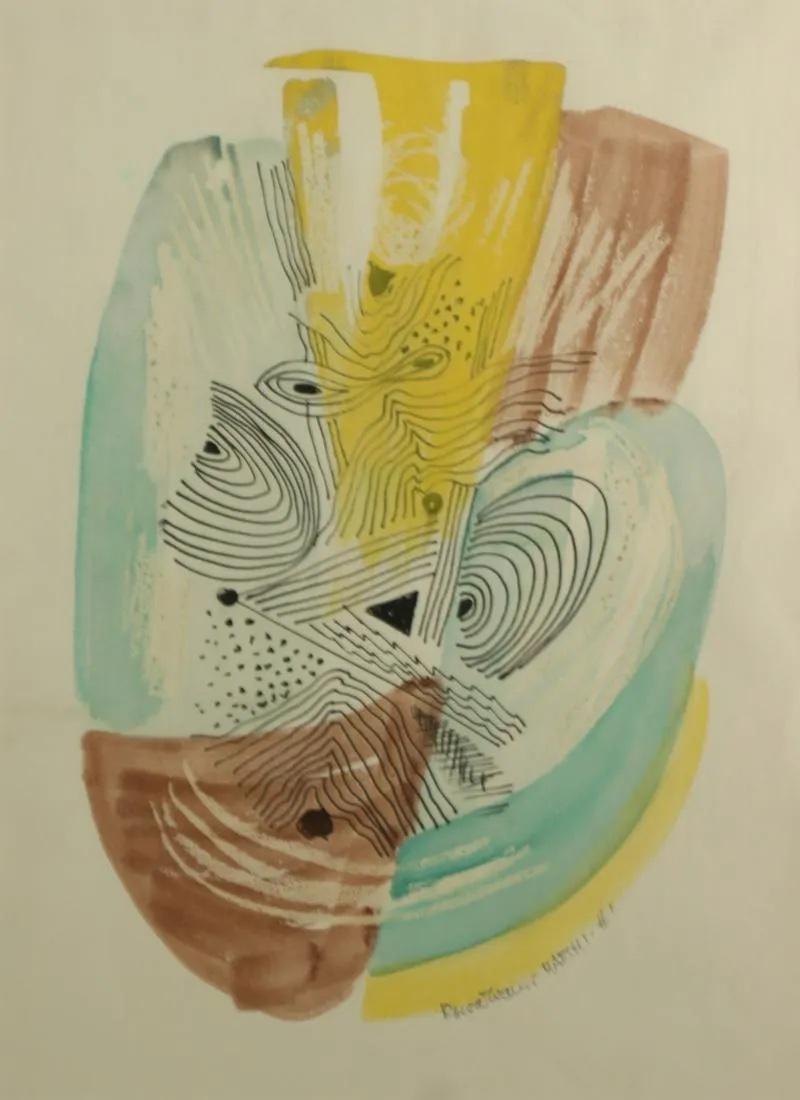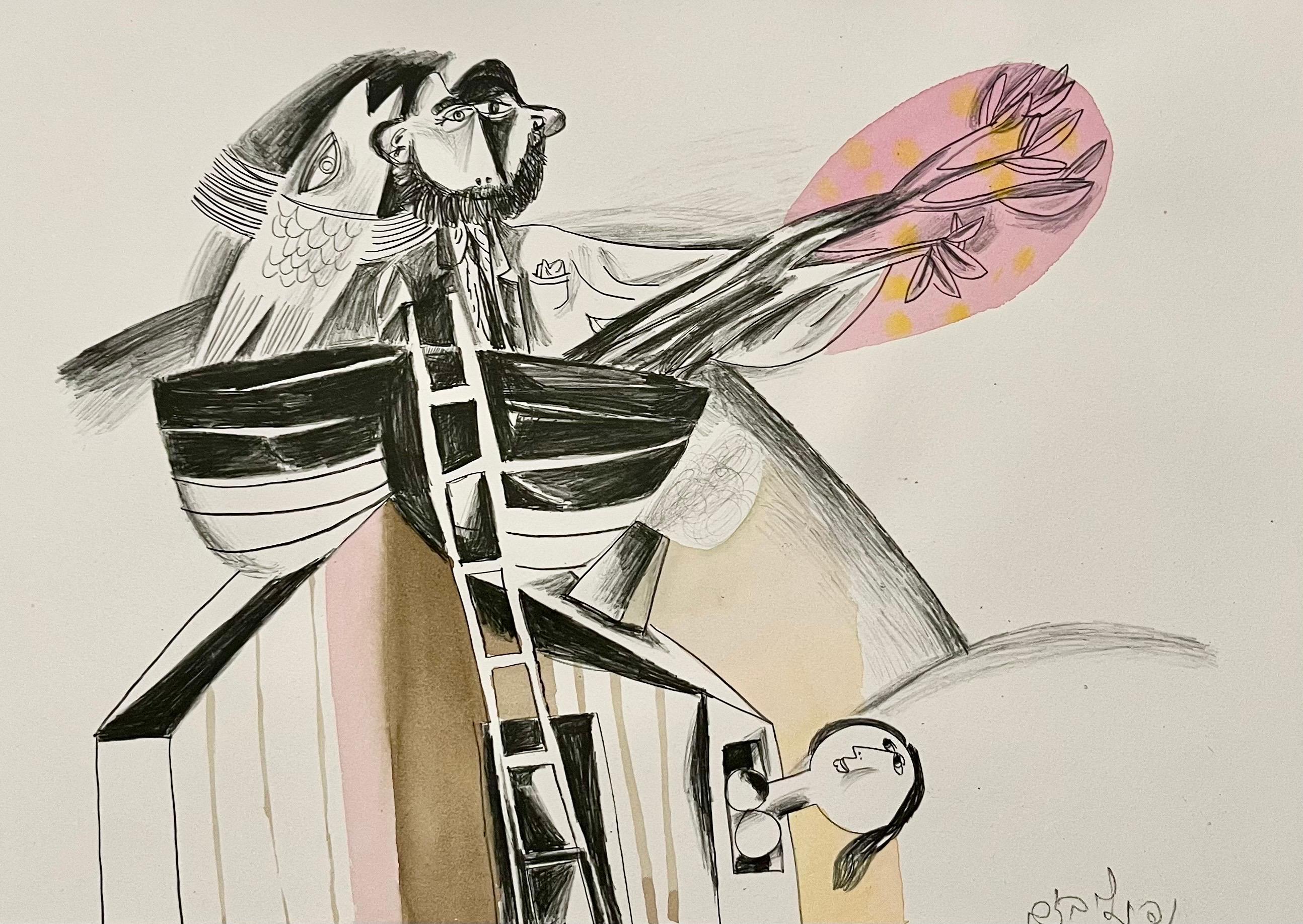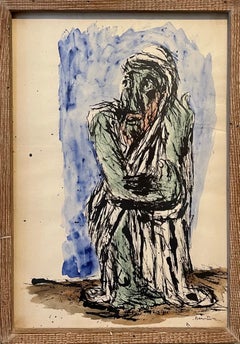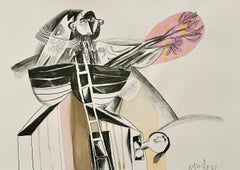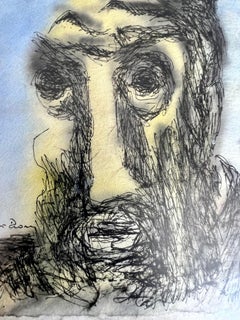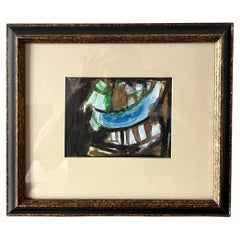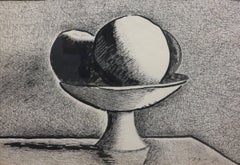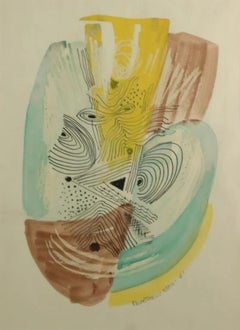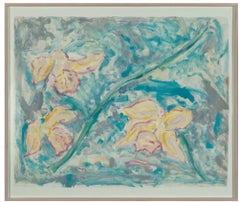Items Similar to Expressionist Ink, Pastel, Crayon Drawing Jewish American Modernist Ben Zion WPA
Want more images or videos?
Request additional images or videos from the seller
1 of 7
Ben-Zion WeinmanExpressionist Ink, Pastel, Crayon Drawing Jewish American Modernist Ben Zion WPAc.1950's
c.1950's
$1,200
£916.03
€1,053.04
CA$1,688.61
A$1,877.81
CHF 986.27
MX$22,958.10
NOK 12,289.82
SEK 11,585.98
DKK 7,859.08
About the Item
Expressionist ink and pastel crayon drawing of beans (carobs, flowers?) in pods
Hand signed.
Born in 1897, Ben-Zion Weinman celebrated his European Jewish heritage in his visual works as a sculptor, painter, and printmaker. Influenced by Spinoza, Knut Hamsun, and Wladyslaw Reymont, as well as Hebrew literature, Ben-Zion wrote poetry and essays that, like his visual work, attempt to reveal the deep “connection between man and the divine, and between man and earth.” An emigrant from the Ukraine, he came to the US in 1920. He wrote fairy tales and poems in Hebrew under the name Benzion Weinman, but when he began painting he dropped his last name and hyphenated his first, saying an artist needed only one name.
Ben-Zion was a founding member of “The Ten: An Independent Group” The Ten” a 1930’s avant-garde group, Painted on anything handy. Ben-Zion often used cabinet doors (panels) in his work. Other members of group included Ilya Bolotowsky, Lee Gatch, Adolph Gottlieb, Louis Harris, Yankel Kufeld, Marcus Rothkowitz (later known as Mark Rothko), Louis Schanker, and Joseph Solman. The Art of “The Ten” was generally described as expressionist, as this style offered the best link between modernism and social art. Their exhibition at the Mercury Gallery in New York held at the same time as the Whitney Annual Exhibition of Contemporary American Painting, included a manifesto concentrating on aesthetic questions and criticisms of the conservative definition of modern art imposed by the Whitney. Ben-Zion’s work was quickly noticed. The New York Sun said he painted “furiously” and called him “the farthest along of the lot.” And the triptych, “The Glory of War,” was described by Art News as “resounding.”
By 1939, The Ten disbanded because most of the members found individual galleries to represent their work. Ben-Zion had his first one-man show at the Artist’s Gallery in Greenwich Village and J.B. Neumann, the highly esteemed European art dealer who introduced Paul Klee, (among others) to America, purchased several of Ben-Zion’s drawings. Curt Valentin, another well-known dealer, exhibited groups of his drawings and undertook the printing of four portfolios of etchings, each composed of Ben-Zion’s biblical themes. He worked as a WPA artist.
Ben-Zion’s work is represented in many museums throughout the country including the Metropolitan, the Whitney, and the Museum of Modern Art in New York, the Art Institute of Chicago, the Philadelphia Museum of Art and the Phillips Collection, Washington. The Jewish Museum in New York opened in 1948 with a Ben-Zion exhibition.
Ben-Zion consistently threaded certain subject matter—nature, still life, the human figure, the Hebrew Bible, and the Jewish people—into his work throughout his life. "In all his work a profound human feeling remains. Sea and sky, even sheaves of wheat acquire a monolithic beauty and simplicity which delineates the transient as a reflection of the eternal. This sensitive inter- mingling of the physical and metaphysical is one of the most enduring features of Ben-Zion's works." (Excerpt from Stephen Kayser, “Biblical Paintings,” The Jewish Museum Catalogue, 1952). Mystical Imprints: Marc Chagall, Ben-Zion, and Ben Shahn presents the print work of three prominent 20th century Jewish artists born in the Russian Empire. Among these seventy pieces are etchings and lithographs from Chagall’s Bible series, Ben-Zion’s full 1980 portfolio The 36 Unknown, Shahn’s iconic The Alphabet of Creation, and more. Organized in partnership with the Hill Museum & Manuscript Library
The tradition of Jewish mysticism as an inspiration for these artists is at the center of the exhibition, from Ben-Zion’s suffering prophets, to Shahn’s Kabbalah influences, to Chagall’s dreamlike images. A contemporary of Ben Shahn, William Gropper, and Abraham Rattner. Ben-Zion continued his style of representational painting based on the abstract, and is perhaps best known for his Biblical paintings, iron sculpture and etchings. Ben-Zion received an American Jewish Congress award.
In 1987, Ben-Zion died in his home in the Chelsea section of Manhattan. He was 90 years old.
- Creator:Ben-Zion Weinman (1897 - 1987, American)
- Creation Year:c.1950's
- Dimensions:Height: 9.75 in (24.77 cm)Width: 11.75 in (29.85 cm)
- Medium:
- Movement & Style:
- Period:
- Condition:Good, minor wear, frame has wear. Please see photos.
- Gallery Location:Surfside, FL
- Reference Number:1stDibs: LU38215777622
About the Seller
4.9
Platinum Seller
Premium sellers with a 4.7+ rating and 24-hour response times
Established in 1995
1stDibs seller since 2014
1,800 sales on 1stDibs
Typical response time: <1 hour
- ShippingRetrieving quote...Shipping from: Surfside, FL
- Return Policy
Authenticity Guarantee
In the unlikely event there’s an issue with an item’s authenticity, contact us within 1 year for a full refund. DetailsMoney-Back Guarantee
If your item is not as described, is damaged in transit, or does not arrive, contact us within 7 days for a full refund. Details24-Hour Cancellation
You have a 24-hour grace period in which to reconsider your purchase, with no questions asked.Vetted Professional Sellers
Our world-class sellers must adhere to strict standards for service and quality, maintaining the integrity of our listings.Price-Match Guarantee
If you find that a seller listed the same item for a lower price elsewhere, we’ll match it.Trusted Global Delivery
Our best-in-class carrier network provides specialized shipping options worldwide, including custom delivery.More From This Seller
View AllAbstract Expressionist Rabbi Watercolor Painting Jewish American Modernist WPA
By Ben-Zion Weinman
Located in Surfside, FL
Watercolor painting of standing prophet or Rabbi, Judaica artwork
Born in 1897, Ben-Zion Weinman celebrated his European Jewish heritage in his visual works as a sculptor, painter, ...
Category
Mid-20th Century Expressionist Abstract Drawings and Watercolors
Materials
Paper, Watercolor
Expressionist Color Drawing Cobalt Glass Vintage Frame Modernist Ben Zion WPA
By Ben-Zion Weinman
Located in Surfside, FL
Expressionist ink and pastel crayon drawing of flowers in vase.
Framed in a vintage cobalt blue glass original frame
Hand signed and dated
Framed it measures 13.5 X 10.5
The actual ...
Category
1950s Expressionist Still-life Drawings and Watercolors
Materials
Paper, Oil Crayon, Pastel, Ink
Rare Israeli Modernist Judaica Watercolor Painting on Lithograph Naftali Bezem
By Naftali Bezem
Located in Surfside, FL
Naftali Bezem (Hebrew: נפתלי בזם; born November 27, 1924) is an Israeli painter, muralist, and sculptor.
Bezem was born in Essen, Germany, in 1924. His early adolescence was spent ...
Category
1970s Modern Figurative Drawings and Watercolors
Materials
Watercolor, Lithograph
Ben ZIon Expressionist Judaica Rabbi Watercolor Painting Jewish Modernist WPA
By Ben-Zion Weinman
Located in Surfside, FL
Frame measures 13.5 X 11.5
Paper measures 6.5 X 5 inches
Hand signed lower right
Watercolor painting of prophet or Rabbi, Judaica artwork
Born in 1897, Ben-Zion Weinman celebrated h...
Category
Mid-20th Century Expressionist Abstract Drawings and Watercolors
Materials
Paper, Watercolor
Expressionist Judaica Havdalah Oil Painting Jewish American Modernist Ben Zion
By Ben-Zion Weinman
Located in Surfside, FL
Oil Painting of still life Havdalah scene with braided candle, spice tower box and kiddush cup.
Born in 1897, Ben-Zion Weinman celebrated his European Jewish heritage in his visual ...
Category
Mid-20th Century Expressionist Still-life Paintings
Materials
Oil, Wood Panel
Abstract with Figures Israeli Mid Century Modernist Woodcut Watercolor Painting
By Stefan Alexander
Located in Surfside, FL
An abstracted composition containing a kneeling figure . this is a stamped print, woodcblock most likely artfully combined with moody watercolor.
Stefan Alexander, born Czechoslovak...
Category
Mid-20th Century Abstract Drawings and Watercolors
Materials
Watercolor, Woodcut
You May Also Like
David Meshulam Framed Work on Paper
By David Meshulam
Located in Chicago, IL
Work on paper by Bulgarian artist David Meshulam. Professionally framed with an off-white matte. The piece depicts 4 or 5 standing figures holding a long blue object. In shades of bl...
Category
Mid-20th Century European Mid-Century Modern Paintings
Materials
Paint, Paper
Still Life (New Hope Mid-century Modernist drawing)
By Lloyd Raymond Ney
Located in Wilton Manors, FL
Beautiful still life drawing by American artist, Lloyd Raymond Ney (1893-1964). Ink on paper, 14.5 x 21 inches; 25.5 x 31.5 inches framed. Excellent condition with no damage or restoration. Signed lower right.
Birth place: Friedenburg, PA.
Addresses: New Hope, PA, 1925-64
Profession: Painter, lecturer, teacher
Studied: PAFA with H. McCarter, 1914 -18 (Cresson Scholarship; traveled in Europe 1918-21; Paris in 1924)
Exhibited: AIC, 1937; Guggenheim Museum, 1941-56; PAFA Ann., 1941, 1951; numerous group shows in Europe.
Work: Guggenheim Museum, NYC. WPA commission, 1941, mural for New London, Ohio Post Office (Citizens of New London petitioned WPA administrator Edward Bruce to allow Ney to paint the mural)
Comments: Abstract painter. He spent many years in Paris, where he was friendly with Pascin, Foujita, Frieske, H.O. Tanner, W. Pach and Roger Fry...
Category
1950s Abstract Still-life Drawings and Watercolors
Materials
Ink
Abstract American Modernism Mid-Century WPA Era Drawing Woodstock 20th Century
By Konrad Cramer
Located in New York, NY
Abstract American Modernism Mid-Century WPA Era Drawing Woodstock 20th Century, Sight size is 16 x 12 inches. The drawing is currently at the framers. A photo will be posted asap.
A...
Category
1930s Abstract Abstract Drawings and Watercolors
Materials
Paper, Ink, Watercolor
Rare Untitled Monotype with Hand Coloring by Ed Baynard
By Ed Baynard
Located in Morton Grove, IL
Ed Baynard (American, 1940- 2016)
Untitled
Monotype with handcoloring on paper!
1981
28-1/2 x 36-3/4 inches (72.4 x 93.3 cm) (paper size)
Frame is included. Approx - 34.5 x 40.75...
Category
1980s Contemporary Still-life Prints
Materials
Monotype
"Other/Kosovo, " Acrylic and Charcoal Drawing on Paper, Abstract, Folk Artist
Located in Houston, TX
This mixed media painting on paper is one in a series of studies leading up to Long’s major ice sculpture installation Other in May of 2000.
Bert L. Long Jr., was self-taught artist, was born in 1940 in Texas, grew up the Houston’s historic Fifth Ward and received his formal education from UCLA. Following a career as a successful master chef, Long decided to devote himself entirely to art in the late 1970’s. Burt Long...
Category
Early 2000s Folk Art Abstract Drawings and Watercolors
Materials
Paper, Charcoal, Acrylic
1945 Wartime Still Life Watercolor English Coveted Ceramic Artist And Teacher
By James Tower
Located in Sutton Poyntz, Dorset
James Tower.
English ( b.1919 - d.1988 ).
Still Life Of Cut Flowers In A Pottery Jug, 1945.
Watercolor & Ink.
Signed & Dated Lower Right.
Image size 13.2 inches x 10 inches ( 33.5c...
Category
Mid-20th Century Post-Impressionist Still-life Drawings and Watercolors
Materials
Paper, Ink, Watercolor
More Ways To Browse
Jewish Museum
Jewish Art Framed
Jewish Russian Painting
1950s Pastel
Chicago Jewish
Modernist Pastel
Jewish Mid Century Art
Paul Klee Exhibition
1980s Pastel
Jewish Etching
Fairy Drawing
Framed Manuscript
Russian Empire Painting
Triptych Drawings
Pastel Vintage Flower Painting
Wpa Lithograph
Jewish Ukraine
Mark Rothko Works On Paper
